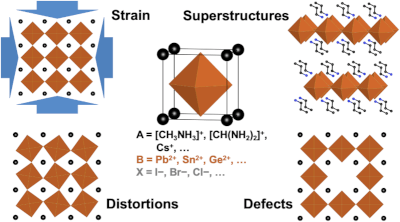Rob’s research group uses density functional theory (DFT)-based computational methods to study relationships among the atomic and electronic structure of solids. Much of this work has focused on solar energy conversion, and on perovskite compounds in particular.
 Perovskites are a structurally diverse class of compounds that can include nearly every element in the periodic table. They are known to exhibit an incredible range of physical phenomena (such as solar absorption, ferroelectricity, ferromagnetism, and superconductivity), which can be harnessed for a variety of real-world applications. Now more than ever, synthetic chemists and materials scientists can manipulate these materials at the nanoscale, providing routes to tune their properties by placing atoms in a rapidly expanding assortment of geometries (see image at left). With these synthetic capabilities comes an increased need to understand the relationships between atomic structure and properties, and to use this understanding to facilitate the discovery of useful new materials.
Perovskites are a structurally diverse class of compounds that can include nearly every element in the periodic table. They are known to exhibit an incredible range of physical phenomena (such as solar absorption, ferroelectricity, ferromagnetism, and superconductivity), which can be harnessed for a variety of real-world applications. Now more than ever, synthetic chemists and materials scientists can manipulate these materials at the nanoscale, providing routes to tune their properties by placing atoms in a rapidly expanding assortment of geometries (see image at left). With these synthetic capabilities comes an increased need to understand the relationships between atomic structure and properties, and to use this understanding to facilitate the discovery of useful new materials.
It is here that theory and computation are extremely valuable. Through chemical intuition and various flavors of electronic structure calculations, our research group aims to design novel materials for target applications. We focus especially on materials for solar energy conversion – photovoltaics and photocatalysts whose function depends directly on electronic structure. Our work is interdisciplinary (at the interface of chemistry, physics, and materials science) and collaborative (because materials are discovered most efficiently when theory and experiment inspire each other).
If you are a student who thinks this research might be up your alley, you are encouraged to contact Robert.Berger@wwu.edu to discuss current research opportunities.
You can learn more about our perovskite research in the following papers:
M.O. Anunobi and R.F. Berger. “Energetic stability and band-edge orbitals of layered inorganic perovskite compounds for solar energy applications”. J. Phys. Chem. C 127, 20217-20225 (2023). Full text
R.F. Berger. “Electronic structure of oxide and halide perovskites”. In Comprehensive Inorganic Chemistry III, eds. J. Reedijk and K. Poeppelmeier, vol. 3, 4-25 (2023). Abstract
C. Teply, B.A. Tyler, and R.F. Berger. “Tuning the band gaps of oxide and halide perovskite compounds via biaxial strain in all directions”. J. Phys. Chem. C 125, 25951-25958 (2021). Abstract
D.V. Cirlincione and R.F. Berger. “Tuning the electronic structure of d0 perovskite oxides by combining distortive modes”. Phys. Rev. B 103, 045127 (2021). Abstract
G.R. McClarin and R.F. Berger. “Confluence of structural distortion and A-site composition in the band gaps of perovskite niobate and tantalate photocatalysts”. Phys. Rev. B 100, 045202 (2019). Abstract
R.F. Berger. “Design principles for the atomic and electronic structure of halide perovskite photovoltaic materials: Insights from computation”. Chem. Eur. J. 24, 8708-8716 (2018). Abstract
K.Y. Tsui, N. Onishi, and R.F. Berger. “Tolerance factors revisited: Geometrically designing the ideal environment for perovskite dopants”. J. Phys. Chem. C 120, 23293-23298 (2016). Abstract
C. Grote and R.F. Berger. “Strain tuning of tin-halide and lead-halide perovskites: A first-principles atomic and electronic structure study”. J. Phys. Chem. C 119, 22832-22837 (2015). Abstract
C. Grote, B. Ehrlich, and R.F. Berger. “Tuning the near-gap electronic structure of tin-halide and lead-halide perovskites via changes in atomic layering”. Phys. Rev. B 90, 205202 (2014). Abstract
Funding and Support




